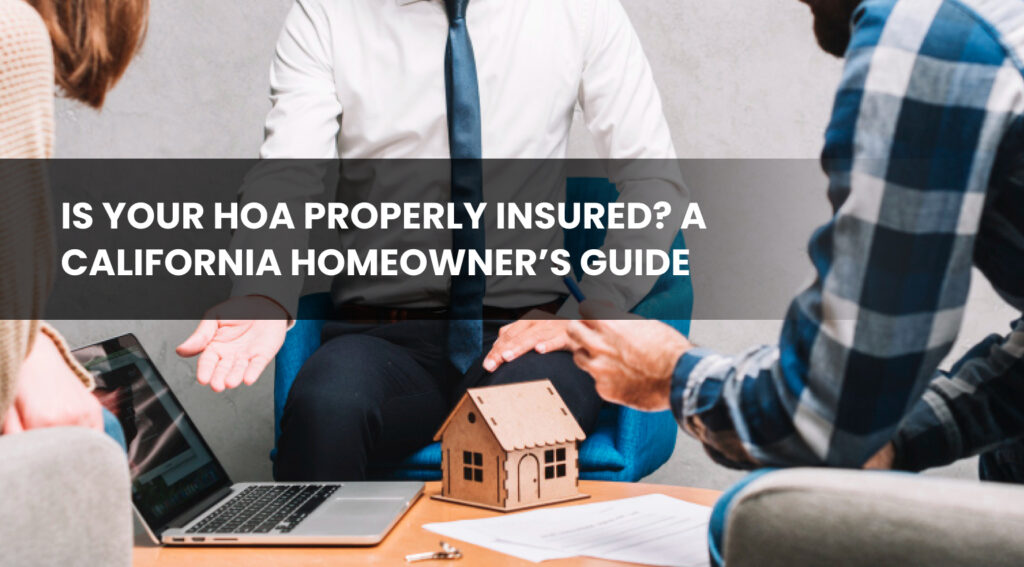
Is Your HOA Properly Insured? A California Homeowner’s Guide
Likely, your home is partially covered by your homeowners association's (HOA) master insurance policy if you live in a community with one. The catch is that "partly" does not equate to "completely."
After learning the hard way that their personal property or specific damages aren't covered, many California homeowners mistakenly believe their HOA covers everything.
Protecting your largest investment requires knowing how HOA insurance in California operates and what is and is not covered.
What Is HOA Insurance?
HOA insurance, often referred to as a “master policy,” is a type of coverage purchased by the homeowners association to protect shared areas and the overall structure of a community. Think of it as the association’s safety net. It typically covers:
- Common areas: Clubhouses, swimming pools, gyms, parking lots, and landscaped zones.
- Exterior structures: Building exteriors, roofs, stairways, and elevators (depending on the community’s setup).
- Liability protection: Injuries or accidents occurring in shared spaces.
To put it briefly, it protects the community overall rather than the individual buildings within it.
What HOA Insurance in California Doesn’t Cover
This is where many homeowners get tripped up. Your HOA policy does not cover your personal belongings, your interior upgrades, or damage inside your home. If there’s a burst pipe that floods your living room or a kitchen fire that damages your cabinets, you’ll need your own HO-6 condo or homeowner policy to cover those losses.
Some common gaps include:
- Interior walls, flooring, and cabinetry.
- Personal belongings (furniture, clothing, electronics).
- Temporary living expenses during repairs.
- Personal liability inside your unit.
So, while the HOA’s master policy handles the outside, you’re responsible for the inside.
The Two Main Types of HOA Master Policies
Policies for HOA insurance in California generally fall into two categories:
- Bare Walls Coverage
This covers only the building’s structure and common areas, essentially the “bare bones” of the property. You’ll need to insure everything inside your walls, from drywall inward.
- All-In Coverage
This is a more comprehensive form of coverage that extends to built-in fixtures and sometimes even interior features like cabinetry and appliances. However, the specifics vary by policy, so homeowners should still check for any exclusions.
Understanding which type your HOA carries helps you know how much supplemental insurance you need.
Why HOA Insurance in California is Especially Important
Earthquakes, wildfires, floods, and other natural hazards that could endanger your property are some of the particular difficulties that come with living in California. The community may not be protected against these frequent California hazards because many HOA policies regrettably do not cover natural disasters.
- Wildfire risk: Many HOAs located near open space or rural zones face higher premiums or coverage limitations.
- Earthquake exclusions: Standard HOA policies rarely include earthquake coverage, which must be purchased separately through an endorsement or a policy from the California Earthquake Authority (CEA).
- Flooding: Similarly, flood coverage typically requires a separate policy under the National Flood Insurance Program (NFIP).
How to Check If Your HOA Is Properly Insured
Here’s a quick checklist for California homeowners:
| Step | What to Do | Why It Matters |
| 1 | Request a copy of your HOA’s insurance declaration page | Shows exactly what’s covered and policy limits |
| 2 | Identify the master policy type (Bare Walls or All-In) | Determines your personal coverage needs |
| 3 | Review exclusions for disasters or high-risk zones | California-specific risks may not be included |
| 4 | Check liability limits | Ensures the HOA can handle major claims or lawsuits |
| 5 | Coordinate with your personal insurer | To fill any gaps between your HO-6 policy and the HOA’s master policy |
By doing this, you can prevent coverage from overlapping or, worse, from being missed entirely.
Why You Still Need Individual Coverage
Even the best HOA insurance won’t replace your personal belongings or protect your interior space. Your HO-6 insurance policy complements the HOA’s master plan, giving you coverage for:
- Personal property replacement.
- Interior fixtures and improvements.
- Personal liability protection.
- Loss of use coverage (hotel stays, rental costs, etc.).
Think of it this way: your HOA protects the neighborhood, but your HO-6 policy protects your home.
Final Thoughts
Although your HOA's insurance policy is essential to preserving the stability of the community, it is not a personal safety net. Knowing what California HOA insurance covers and where it doesn't helps California homeowners make more informed decisions about their own coverage. If you're not sure if your personal policy covers the gaps or if your HOA has adequate coverage, speak with a reliable insurance expert.
Contact e360 Insurance Services, your go-to source for complete protection and peace of mind, for knowledgeable advice on HOA insurance in California and customized coverage options.
